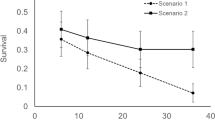Abstract
The Burmese python (Python molurus bivittatus) is established in Everglades National Park and neighboring areas in south Florida. Beyond its substantial ecological impacts to native fauna in south Florida, concerns have been raised as to its potential to occupy other parts of the USA, even as far north as Washington, DC. During a recent period of cold weather, seven of nine captive Burmese pythons held in outdoor pens at our facility in north-central Florida died, or would have died absent our intervention. This cold-induced mortality occurred despite the presence of refugia with heat sources. Our findings cast doubt on the ability of free-ranging Burmese pythons to establish and persist beyond the subtropical environment of south Florida.
Similar content being viewed by others
References
Aubret F, Shine R (2010) Thermal plasticity in young snakes: how will climate change affect the thermoregulatory tactics of ectotherms? J Exp Biol 213:242–248
Barker DG (2008) Will they come in out of the cold? Observations of large constrictors in cool and cold conditions. Bull Chicago Herpetol Soc 43:93–97
Bilger B (2009) Swamp things. New Yorker 85:80–89
Collins TM, Freeman B, Snow S (2008) Final report: genetic characterization of populations of the nonindigenous Burmese python in Everglades National Park. Final report for the South Florida Water Management District. Department of Biological Sciences, Florida International University, Miami, Florida
Jacobs HJ, Auliya M, Böhme W (2009) Zur taxonomie des dunklen tigerpythons, Python molurus bivittatus Kuhl, 1820, speziell der population von Sulawesi. Sauria 31:5–16
Meshaka WE Jr, Loftus WF, Steiner T (2000) The herpetofauna of Everglades National Park. Florida Sci 63:84–103
Pyron RA, Burbrink FT, Guiher TJ (2008) Claims of potential expansion throughout the U.S. by invasive python species are contradicted by ecological niche models. PLoS ONE 3:e2931
Rodda GH, Jarnevich CS, Reed RN (2009) What parts of the US mainland are climatically suitable for invasive alien pythons spreading from Everglades National Park? Biol Inv 11:241–252
Snow RW, Krysko KL, Enge KM, Oberhofer L, Walker-Bradley A, Wilkins L (2007) Introduced populations of Boa constrictor (Boidae) and Python molurus bivittatus (Pythonidae) in southern Florida. In: Henderson RW, Powell R (eds) The biology of boas and pythons. Eagle Mountain Publishing, Eagle Mountain, UT, pp 416–438
Acknowledgments
We appreciate the efforts of R. W. Snow in acquiring the pythons for us. We thank E. Fetzer and K. Maciejewski for assistance in caring for the snakes.
Author information
Authors and Affiliations
Corresponding author
Rights and permissions
About this article
Cite this article
Avery, M.L., Engeman, R.M., Keacher, K.L. et al. Cold weather and the potential range of invasive Burmese pythons. Biol Invasions 12, 3649–3652 (2010). https://doi.org/10.1007/s10530-010-9761-4
Received:
Accepted:
Published:
Issue Date:
DOI: https://doi.org/10.1007/s10530-010-9761-4




